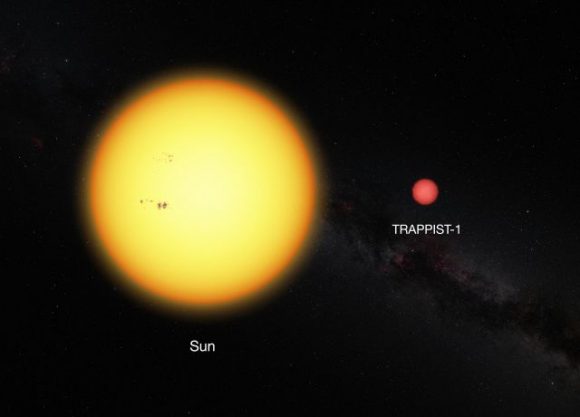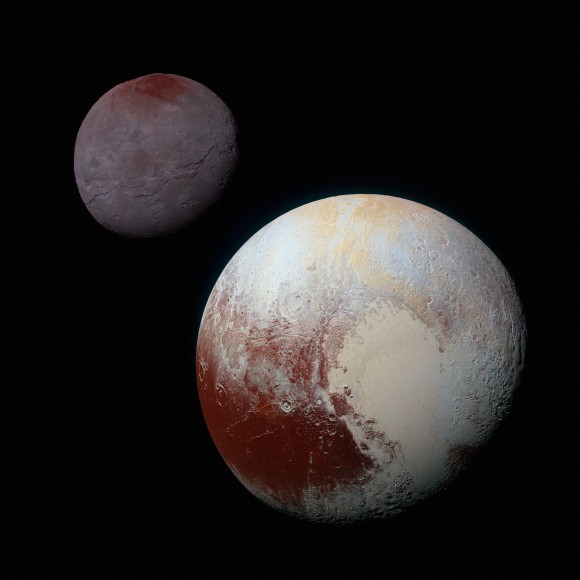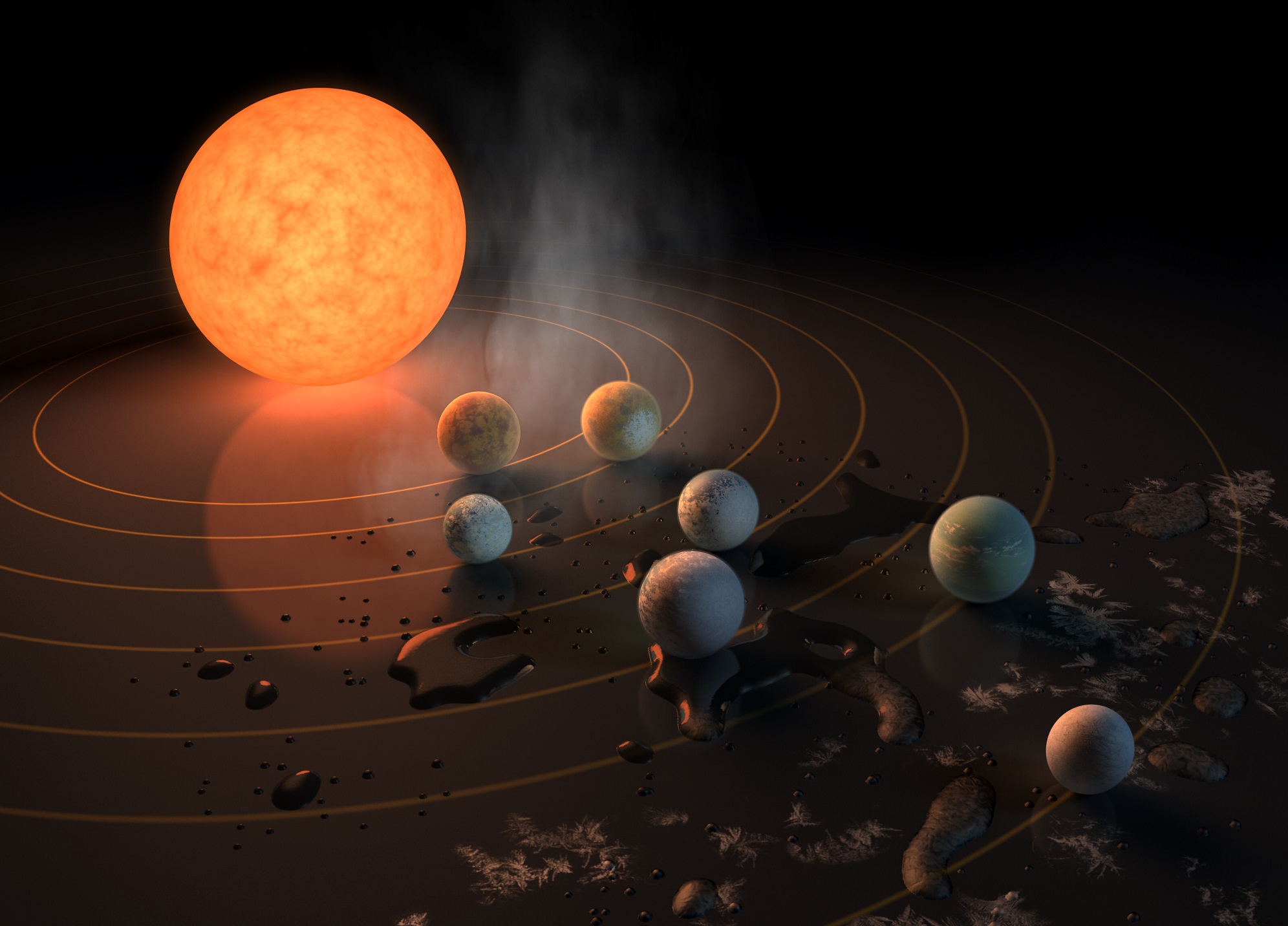NASA’s announcement last week of 7 new exoplanets is still causing great excitement. Any time you discover 7 “Earth-like” planets around a distant star, with 3 of them “potentially” in the habitable zone, it’s a big deal. But now that we’re over some of our initial excitement, let’s look at some of the questions that need to be answered before we can all get excited again.
What About That Star?
The star that the planets orbit, called Trappist-1, is a Red Dwarf star, much dimmer and cooler than our Sun. The three potentially habitable planets—TRAPPIST-1e, f, and g— get about the same amount of energy as Earth and Mars do from the Sun, because they’re so close to it. Red Dwarfs are very long-lasting stars, and their lifetimes are measured in the trillions of years, rather than billions of years, like our Sun is.
But Red Dwarfs themselves can have some unusual properties that are problematic when it comes to supporting life on nearby planets.

Red Dwarfs can be covered in starspots, or what we call sunspots when they appear on our Sun. On our Sun, they don’t have much affect on the amount of energy received by the Earth. But on a Red Dwarf, they can reduce the energy output by up to 40%. And this can go on for months at a time.
Other Red Dwarfs can emit powerful flares of energy, causing the star to double in brightness in mere minutes. Some Red Dwarfs constantly emit these flares, along with powerful magnetic fields.
Part of the excitement surrounding the Trappist planets is that they show multiple rocky planets in orbit around a Red Dwarf. And Red Dwarfs are the most common type of star in the Milky Way. So, the potential for life-supporting, rocky planets just grew in a huge way.
But we don’t know yet how the starspots and flaring of Red Dwarfs will affect the potential habitability of planets orbiting them. It could very well render them uninhabitable.
Will Tidal Locking Affect the Planets’ Habitability?
The planets orbiting Trappist-1 are very likely tidally locked to their star. This means that they don’t rotate, like Earth and the rest of the planets in our Solar System. This has huge implications for the potential habitability of these planets. With one side of the planet getting all the energy from the star, and the other side in perpetual darkness, these planets would be nothing like Earth.

One side would be constantly roasted by the star, while the other would be frigid. It’s possible that some of these planets could have atmospheres. Depending on the type of atmosphere, the extreme temperature effects of tidal locking could be mitigated. But we just don’t know if or what type of atmosphere any of the planets have. Yet.
So, Do They Have Atmospheres?
We just don’t know yet. But we do have some constraints on what any atmospheres might be.
Preliminary data from the Hubble Space Telescope suggests that TRAPPIST 1b and 1c don’t have extended gas envelopes. All that really tells us is that they aren’t gaseous planets. In any case, those two planets are outside of the habitable zone. What we really need to know is if TRAPPIST 1e, 1f, and 1g have atmospheres. We also need to know if they have greenhouse gases in their atmospheres. Greenhouse gases could help make tidally locked planets hospitable to life.
On a tidally locked planet, the termination line between the sunlit side and the dark side is considered the most likely place for life to develop. The presence of greenhouse gases could expand the habitable band of the termination line and make more of the dark side warmer.
We won’t know much about any greenhouse gases in the atmospheres of these planets until the James Webb Space Telescope (JWST) and the European Extremely Large Telescope (EELT) are operating. Those two ‘scopes will be able to analyze the atmospheres for greenhouse gases. They might also be able to detect biosignatures like ozone and methane in the atmospheres.
We’ll have to wait a while for that though. The JWST doesn’t launch until October 2018, and the EELT won’t see first light until 2024.
Do They Have Liquid Water?
We don’t know for sure if life requires liquid water. We only know that’s true on Earth. Until we find life somewhere else, we have to be guided by what we know of life on Earth. So we always start with liquid water.
A study published in 2016 looked at planets orbiting ultra-cool dwarfs like TRAPPIST-1. They determined that TRAPPIST 1b and 1c could have lost as much as 15 Earth oceans of water during the early hot phase of their solar system. TRAPPIST 1d might have lost as much as 1 Earth ocean of water. If they had any water initially, that is. But the study also shows that they may have retained some of that water. It’s not clear if the three habitable planets in the TRAPPIST system suffered the same loss of initial water. But if they did, they could have retained a similar amount of water.

There are still a lot of questions here. The word “habitable” only means that they are receiving enough energy from their star to keep water in liquid form. Since the planets are tidally locked, any water they did retain could be frozen on the planets’ dark side. To find out for sure, we’ll have to point other instruments at them.
Are Their Orbits Stable?
Planets require stable orbits over a biologically significant period of time in order for life to develop. Conditions that change too rapidly make it impossible for life to survive and adapt. A planet needs a stable amount of solar radiation, and a stable temperature, to support life. If the solar radiation, and the planet’s temperature, fluctuates too rapidly or too much due to orbital instability, then life would not be able to adapt to those changes.
Right now, there’s no indication that the orbits of the TRAPPIST 1 planets are unstable. But we are still in the preliminary stage of investigation. We need a longer sampling of their orbits to know for sure.
Pelted by Interlopers?
Our Solar System is a relatively placid place when it comes to meteors and asteroids. But it wasn’t always that way. Evidence from lunar rock samples show that it may have suffered through a period called the “Late Heavy Bombardment.” During this time, the inner Solar System was like a shooting gallery, with Earth, Venus, Mercury, Mars, and our Moon being struck continuously by asteroids.
The cause of this period of Bombardment, so the theory goes, was the migration of the giant planets through the solar system. Their gravity would have dislodged asteroids from the asteroid belt and the Kuiper Belt, and sent them into the path of the inner, terrestrial planets.
We know that Earth has been hit by meteorites multiple times, and that at least one of those times, a mass extinction was the result.

The TRAPPIST 1 system has no giant planets. But we don’t know if it has an asteroid belt, a Kuiper Belt, or any other organized, stable body of asteroids. It may be populated by asteroids and comets that are unstable. Perhaps the planets in the habitable zone are subjected to regular asteroid strikes which wipes out any life that gets started there. Admittedly, this is purely speculative, but so are a lot of other things about the TRAPPIST 1 system.
How Will We Find Out More?
We need more powerful telescopes to probe exoplanets like those in the TRAPPIST 1 system. It’s the only way to learn more about them. Sending some kind of probe to a solar system 40 light years away is something that might not happen for generations, if ever.
Luckily, more powerful telescopes are on the way. The James Webb Space Telescope should be in operation by April of 2019, and one of its objectives is to study exoplanets. It will tell us a lot more about the atmospheres of distant exoplanets, and whether or not they can support life.
Other telescopes, like the Giant Magellan Telescope (GMT) and the European Extremely Large Telescope (E-ELT), have the potential to capture images of large exoplanets, and possibly even Earth-sized exoplanets like the ones in the TRAPPIST system. These telescopes will see their first light within ten years.

What these questions show is that we can’t get ahead of ourselves. Yes, it’s exciting that the TRAPPIST planets have been discovered. It’s exciting that there are multiple terrestrial worlds there, and that 3 of them appear to be in the habitable zone.
It’s exciting that a Red Dwarf star—the most common type of star in our neighborhood—has been found with multiple rocky planets in the habitable zone. Maybe we’ll find a bunch more of them, and the prospect of finding life somewhere else will grow.
But it’s also possible that Earth, with all of its life supporting and sustaining characteristics, is an extremely unlikely occurrence. Special, rare, and unrepeatable.


Can Nasa just stop with the artist renderings? They know nothing about these planets, NOTHING!!! These artists drawings are pure speculative crap and are not helping. I know they want to stir up some excitement about this and other planetary discoveries, but the findings themselves are exciting enough. There is no need to create false images of planets.
YOU COULD NOT HAVE SAID THIS ANY BETTER, THOMASGUIDE
I haven’t seen any false images of planets, this is a major discovery, and anyway, images are helpful for the common citizen, be more positive please
How do we know these planets are tidally locked? Theory, right? From Cornell U: “Anyway, the bottom line is that stars like the Sun spin from the original angular momentum that was there in the solar nebula from which it formed. Not only that, all orbital motion of the planets (including the spin) is due to this original angular momentum.” http://curious.astro.cornell.edu/about-us/56-our-solar-system/planets-and-dwarf-planets/general-questions/218-why-do-planets-rotate-intermediate
A planet CAN slow it’s rotation due to gravitational influences from a moon or close proximity to other planets within a system. This is called tidal friction. It may well be that the age of a Red Dwarf system allows those types of interactions to be inevitable, but there are so many factors it is at present, impossible to say.
Hopefully in future, we’ll be able to tell if these planets have substantial moons and more clearly define their orbital and rotational characteristics.
Kenneth Funderburgh
10:12 AM (5 hours ago)
to ailiff
IS MY FORMULA RIGHT? AND DO YOU WANT RESERVATIONS ON OUR FIRST FLIGHT? BRING ABUNDANCE OF PROVISIONS, KIND OF A LONG TRIP. http://www.universetoday.com/…/seti-already-tried-listenin…/ I HAVE BEEN GIVING NASA A LITTLE BIT OF HELL, WITH ALL OUR TAX DOLLARS THEY SPEND.
NASA AND THEIR NEW PLANET FINDS, AND 40 LIGHT YEARS. DO YOU KNOW HOW MANY MILES AWAY THAT IS??? 186,000X60X60X24X365X40 = 40 LIGHT YEARS. 234,454,700,000,000 (TRILLION,BILLION,MILLION) MILES. LETS JUST SAY OUR FASTEST SPACE VEHICLE TRAVELS AT 35,000 MPH, AND THE MILEAGE ABOVE (234,627,840,000,000) IS THE DISTANCE WE HAVE TO TRAVEL TO GET TO VISIT EXOPLANETS TRAPPIST – 1.. THE ROUND TRIP (MY ESTIMATION) WOULD TAKE 1,530,514 YEARS. THE BIG QUESTION HERE IS, HOW MANY PEOPLE WOULD IT TAKE ON BOARD TO GET THERE AND BACK. YES, OF COURSE, THERE IS FOOD AND FUEL INVOLVED. THIS IS SO OUTLANDISH I BELIEVE THAT NASA’S BUDGET SHOULD BE SLASHED BY 90 PERCENT. THEIR BUDGET FOR 2016 WAS 17 AND HALF BILLION. I THINK THEY COULD OPERATE WITH JUST A BILLION AND A HALF.
IS IT NOT TRUE THAT NASA ONLY SUPPOSEDLY FINDS SOMETHING PHENOMENAL WHEN THEY NEED GRANT MONIES FOR THEIR CONTINUED NONSENSICAL OPERATION. WE COULD USE THOSE MONIES HERE ON EARTH TO SOLVE A LOT OF PROBLEMS???!!!! DOES OUR NASA TELESCOPES SEE THAT FAR, AND THEN INTELLIGENTLY RECOGNIZE WHAT THEY ARE VIEWING ??? NASA IS VERY ANGRY BECAUSE THE DINASARS ON TRAPPIST – 1 SYSTEMS, WILL NOT ANSWER THEIR PHONE CALLS….
Kenneth Funderburgh
10:12 AM (5 hours ago)
I HAVE ADDED TO THIS>>
to ailiff
IS MY FORMULA RIGHT? AND DO YOU WANT RESERVATIONS ON OUR FIRST FLIGHT? BRING ABUNDANCE OF PROVISIONS, KIND OF A LONG TRIP. http://www.universetoday.com/…/seti-already-tried-listenin…/ I HAVE BEEN GIVING NASA A LITTLE BIT OF HELL, WITH ALL OUR TAX DOLLARS THEY SPEND.
NASA AND THEIR NEW PLANET FINDS, AND 40 LIGHT YEARS. DO YOU KNOW HOW MANY MILES AWAY THAT IS??? 186,000X60X60X24X365X40 = 40 LIGHT YEARS. 234,454,700,000,000 (TRILLION,BILLION,MILLION) MILES. LETS JUST SAY OUR FASTEST SPACE VEHICLE TRAVELS AT 35,000 MPH, AND THE MILEAGE ABOVE (234,627,840,000,000) IS THE DISTANCE WE HAVE TO TRAVEL TO GET TO VISIT EXOPLANETS TRAPPIST – 1.. THE ROUND TRIP (MY ESTIMATION) WOULD TAKE 1,530,514 YEARS. THE BIG QUESTION HERE IS, HOW MANY PEOPLE WOULD IT TAKE ON BOARD TO GET THERE AND BACK. YES, OF COURSE, THERE IS FOOD AND FUEL INVOLVED. THIS IS SO OUTLANDISH I BELIEVE THAT NASA’S BUDGET SHOULD BE SLASHED BY 90 PERCENT. THEIR BUDGET FOR 2016 WAS 17 AND HALF BILLION. I THINK THEY COULD OPERATE WITH JUST A BILLION AND A HALF.
IS IT NOT TRUE THAT NASA ONLY SUPPOSEDLY FINDS SOMETHING PHENOMENAL WHEN THEY NEED GRANT MONIES FOR THEIR CONTINUED NONSENSICAL OPERATION. WE COULD USE THOSE MONIES HERE ON EARTH TO SOLVE A LOT OF PROBLEMS???!!!! DOES OUR NASA TELESCOPES SEE THAT FAR, AND THEN INTELLIGENTLY RECOGNIZE WHAT THEY ARE VIEWING ??? NASA IS VERY ANGRY BECAUSE THE DINASARS ON TRAPPIST – 1 SYSTEMS, WILL NOT ANSWER THEIR PHONE CALLS….
Why are you so negative about this major discovery??!! we don’t have to GO there!! all we need to do is find signs of life elsewhere and change humanity. YES, finding life elsewhere will change humanity forever.
Finding life on another planet would change life as we know it. If the beings on another planet are more advanced than us, we could learn from them. Same goes for them. We would be able to get new technology. We don’t have to go there.